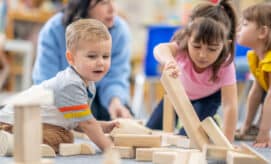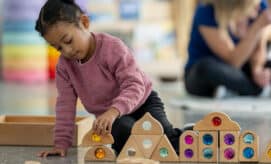Montessori is one of the most widely known educational philosophies used in early learning environments. In Montessori classrooms, the curriculum emphasizes child-directed learning through activities that encourage inquiry, independence, and hands-on exploration. This article introduces the basics of the Montessori approach, and describes the key components of the Montessori curriculum and classroom.
Origins of the Montessori Curriculum
The Montessori approach to education was developed in the early 1900s by Dr. Maria Montessori, an Italian physician and anthropologist who devoted her life to learning about child development. She believed that children have a natural inclination towards learning, and that a high-quality curriculum is one that gives children the freedom to explore.
Maria Montessori observed that children develop self-confidence and experience the joy of learning when they are allowed autonomy and the opportunity to follow their interests.
Classrooms that Support Curriculum
Montessori classrooms are comfortable spaces that are designed to help young children feel relaxed and at-home. Furniture, sinks, and all materials are placed at the child’s eye-level and within reach, so that they are easily accessible. The classroom features open shelves that display specifically designed activities and materials. When you enter a Montessori space, you are likely to observe the children at tables and on the floor on mats, working individually or in small groups.
Multi-Age Classrooms
In Montessori classrooms, children of different ages work and learn together, in the same space. Guidepost Montessori explains that multi-age classrooms are “fundamental to the Montessori Method.”
In preschool Montessori classrooms, for example, you will likely see children between the ages of 3 and 5 years old in the same space, to create opportunities for learning and leadership. Guidepost Montessori adds: “Older students have the chance to become mentors to their younger classmates while learning and practicing important leadership skills. Younger children naturally look up to and emulate older children, and so in a classroom with a range of ages, there are always opportunities for a child to ‘graduate’ from observer to leader. Older students also find great joy in being trusted to teach their younger peers.”
Work & Work Cycles
Maria Montessori famously said, “play is the work of the child”, and in Montessori classrooms, children’s play is referred to as their “work”. According to Montessori-certified educator, Sue Brons, “The word ‘work’ is a respectful way of referring to the natural inclination to explore and learn, or as most people refer to it, play. Purposeful play.”
In programs that follow a Montessori curriculum, children spend time working at their own pace on a variety of activities during uninterrupted blocks of work time. These are referred to as “work cycles,” in which children select an activity, work on it for as long as they would like, and then clean it up before moving on to the next activity of their choice. Purposeful play, or “work”, describes activities that are fun and enjoyable for children, while providing enough of a challenge to support learning and development.
Classroom Ground Rules
Montessori classrooms are set up in such a way that children are able to move about freely, within the limits of the classroom rules and expectations. Classroom rules are referred to as “ground rules,” which are described by The American Montessori Society: “At all age-levels, the ground rules are simple—children are free to work with any material or activity displayed in the environment as long as they use it respectfully. They may not harm the material, themselves, or others.”
Incorporating Montessori Curriculum Ideas Into Your Classroom
It is worth noting that Montessori programs tend to adhere strictly to the guidelines of this philosophy. In Montessori schools, all educators are trained and certified in the Montessori approach and use specific Montessori materials to set up the learning environment.
However, the Montessori philosophy offers inspiring ideas for any early learning provider or program! Below are some examples of elements from the Montessori curriculum that might work well for the young children in your program.
Encourage Opportunities for Multi-age Learning
There is significant value in giving children opportunities to spend time with older and younger children, a feature of the Montessori curriculum. If you work in an early learning center in which classrooms are broken up by age, you might reach out to one of the other teachers to see if you can set up some time for the two age groups to do an activity together, or even just play outside together. This gives younger children an opportunity to observe and learn from the older children, while older children can practice leadership and guidance.
If you work in a smaller center, or a home-based program, you might already work in an environment in which children of mixed ages are in the same space. In this case, you might consider pairing an older and younger child for a specific project or activity, encouraging them to collaborate and learn together.
Focus on Independence
Children are naturally inquisitive and interested in trying new things. We can support their curiosity by encouraging them to take the lead when they do something for the first time. Invite children in your care to select their own activities, and encourage them to work independently on them for a small amount of time, without interruption. If they get stuck or are in need of help, offer affirmation and encouragement, without solving the problem for them.





